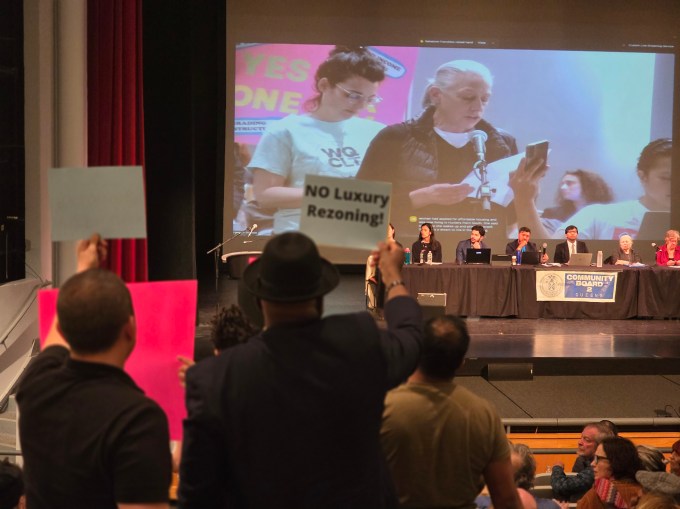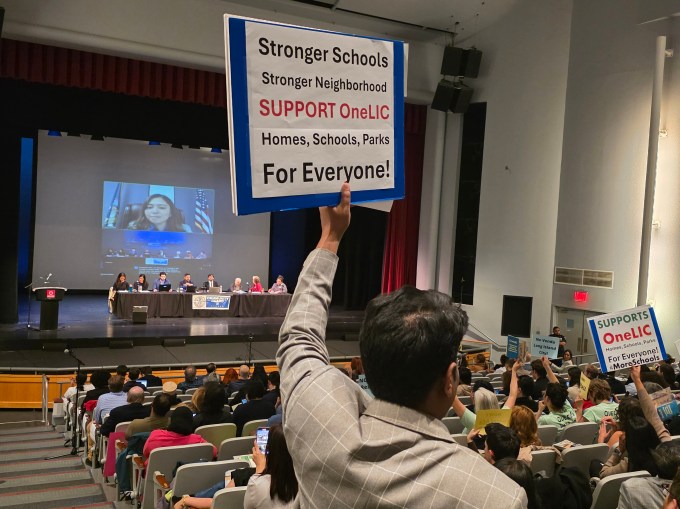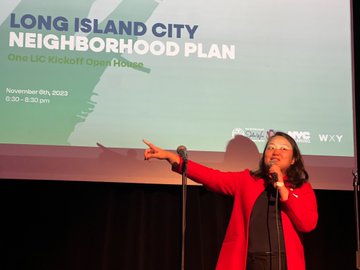
Supporters and opponents of the OneLIC plan held placards aloft throughout Wednesday’s hearing. Photo: Shane O’Brien
May 22, 2025 By Shane O’Brien
More than 500 people filled the Main Stage Theater at LaGuardia Community College on Wednesday evening for a joint Community Board 1 and 2 hearing on the OneLIC neighborhood plan, with testimony stretching over three hours during a passionate and, at times, heated forum.
Over 100 residents offered testimony on the sweeping proposal, which seeks to transform a significant portion of Long Island City by introducing new zoning regulations that would allow for nearly 14,700 housing units—including 4,300 designated as affordable.
The plan is a collaborative initiative between Council Member Julie Won, the Department of City Planning, and the Adams administration. In addition to housing, it proposes more than 3 million square feet of commercial space, new schools, expanded waterfront access, and increased open space, according to supporters.
Spanning 54 full or partial blocks, the rezoning area stretches from Gantry Plaza State Park to the Queensbridge Houses and north to the Long Island City Industrial Business Zone. Its eastern boundary runs through Court Square and 23rd Street. The plan aims to update outdated zoning rules to promote mixed-use development, increase housing supply, and improve infrastructure and climate resiliency.

Residents express both support and opposition to the OneLIC neighborhood plan. Photo: Shane O’Brien.
According to the Adams administration, the OneLIC plan, which entered the public review process last month, would deliver more than 4,000 affordable homes through Mandatory Inclusionary Housing (MIH), a zoning mechanism that requires developers to include affordable units in areas that are rezoned for higher-density residential development.
Since its launch in November 2023, the plan has drawn mixed reactions. Supporters argue that it would bring much-needed housing, jobs, and community amenities to Long Island City, while critics contend that the proposal favors developers and could lead to the displacement of lower-income residents currently living in the neighborhood.
Those tensions were on full display Wednesday night in the Main Stage Theater at LaGuardia Community College’s Building E (31-10 Thomson Ave.), where both sides turned out in large numbers for the first official hearing on the plan as part of the city’s Uniform Land Use Review Procedure (ULURP).

Photo: Shane O’Brien.
Throughout the evening, attendees waved placards reflecting their stance on the proposal. Opponents held signs with messages such as “No Luxury Rezoning” and “Don’t Displace Us,” and regularly interrupted proceedings by chanting “vote no” between testimonies.
Those in favor, on the other hand, held placards proclaiming that the plan would introduce “stronger infrastructure” and “more schools.”

Photo: Shane O’Brien
Opponents of the plan urged Community Board 1 and 2 members to vote “no” when they cast their advisory votes next month as part of the ULURP process. Several speakers gave impassioned testimony, warning that the proposal could accelerate gentrification and displace longtime residents from the neighborhood.
Critics also raised concerns about the area’s infrastructure capacity, noting that some proposed developments lie outside the Long Island City floodplain and could place additional strain on already overburdened systems.
Supporters, however, encouraged board members to approve the plan, pointing to the city’s worsening housing affordability crisis. They argued that without a significant increase in housing supply, costs would continue to rise—pricing out working families. Proponents also emphasized the plan’s expanded open space, waterfront access, and new schools as essential additions to a growing community.
Opponents countered that none of those amenities are legally guaranteed in the plan, expressing skepticism about whether open space, school seats, or infrastructure improvements would ever materialize. In response, officials close to Council Member Julie Won clarified that such skepticism is not entirely accurate—explaining that Won has made clear she will vote against the proposal during the final City Council ULURP vote unless it includes explicit commitments to community priorities.
Won’s priorities include a fully connected waterfront esplanade stretching from Gantry Plaza State Park to Queensbridge Park in addition to a commitment to permanently affordable housing at a range of income levels. She is also calling for new capital funding for sewage and plumbing infrastructure to address current flooding and support future development as well as expanded school seats and park space, particularly underneath the Queensboro Bridge.
Won has signaled that she will vote against the plan if those priorities are not included, thereby guaranteeing that any plan that makes it through ULURP will include explicit commitments to the local community.

Council Member Julie Won at a previous community planning town hall. (Photo courtesy of Won’s office)
“I will not green light this project if the City fails to meet our collective demands,” Won said in a statement issued after the hearing.
Won called on residents to continue speaking out as the OneLIC plan advances through the ULURP process, emphasizing that the proposal will not succeed unless it meets the community’s “minimum requirements.”
According to Won’s office, 68 people spoke in favor of the plan during Wednesday night’s hearing, while 35 voiced opposition. An additional 11 speakers did not indicate a clear position. Community Board 2 Chair Anatole Ashraf noted that a majority of those who have submitted written testimony by email so far have also expressed support for the proposal.
Still, Won’s office emphasized that a “clear majority” of participants have consistently called for the city to “double down” on the priorities identified through the 18-month community engagement process that informed the plan’s early stages.
State Senator Kristen Gonzalez, speaking remotely from Albany, voiced concerns about the neighborhood’s existing infrastructure challenges, citing increased traffic, strained school capacity, and limited open space as ongoing issues. She warned that the plan proposes a significant population increase, which could further strain services if not met with adequate investment.
“We deserve public recreation sites,” Gonzalez said. “We deserve increases in the number of school seats, and we also deserve cultural sites—live-work spaces that support the growth of our neighborhood as an arts and culture hub.”
Gonzalez also called for improvements to public transportation, including additional 7, E, F, and G train service, and said the Department of Transportation must implement substantial traffic engineering upgrades to manage the impacts of a growing population.
Dozens of speakers sharply criticized the plan during the hearing, including several members of the Western Queens Community Land Trust (WQCLT).
Jenny Dabnau, a WQCLT member, said the neighborhood deserves a “community-led” and comprehensive planning process. She described the current proposal as one that would primarily benefit developers, adding “a tremendous amount of unaffordable housing” while doing little for existing residents.

Photo: Shane O’Brien
Astoria resident Andrea Mungo echoed those concerns, saying the plan promises “shiny new buildings” but fails to account for the people who already call Long Island City home.
“The people it does not provide for—the poor, the struggling artists, small business owners who can’t find affordable space to rent—are unseen and forgotten,” Mungo said, drawing loud cheers from a vocal group of opponents. “The powerful and the wealthy again benefit from the inequities of yet another super rezoning in New York City.”
Dannelly Rodriguez, an Astoria-based housing attorney who represents tenants facing eviction, delivered a passionate speech denouncing the proposal as “another gentrification project.”
“This is not for Queensbridge. This is not for Ravenswood. This is not for Astoria. This is not for the working people in the city,” Rodriguez said during the hearing.
In comments to this publication following the event, Rodriguez raised concerns that the Mandatory Inclusionary Housing (MIH) framework used in the plan would still price out many low-income households, as income thresholds often exceed the actual median income of New York City residents. “OneLIC is a golden plate for developers,” Rodriguez said.
Albert Scott, another attendee, described the proposal as “economic warfare against working families” and warned that it could set a precedent for similarly aggressive rezonings in other New York City neighborhoods.
Jay Koo, a Sunnyside resident who said he was previously displaced from the Lower East Side, voiced skepticism that adding market-rate housing would lower rent prices. “I used to believe more housing meant lower rent. It didn’t,” Koo said, calling the OneLIC plan a project “for the gentrifiers.”
Several residents echoed those concerns, calling on the city to scrap or significantly modify the plan before it moves forward.
Still, dozens of other speakers voiced support for the proposal, underscoring the need for increased housing supply and long-term investments in the neighborhood’s infrastructure, schools, and green space.

Photo: Shane O’Brien
Astoria resident Dan Miller urged Council Member Won and both community boards to support the plan, citing the city’s extremely low 1.4% vacancy rate and emphasizing the urgent need to increase housing supply in Long Island City.
“I urge the council member to support it and to make sure that we get as much housing as possible—all types, affordable and market-rate,” Miller said. “Everything helps. We need every single apartment we can get.”
Numerous members of the Bangladeshi community in Long Island City also expressed support for the project, some holding placards highlighting benefits such as improved infrastructure and new schools.
Rob Basch, president of the Hunters Point Parks Conservancy, acknowledged that the plan is “not perfect,” but said it’s time to move forward after years of delay. He pointed to the fallout from the canceled Amazon HQ2 project, noting that six years later, no viable alternative has materialized.
“I walk down Vernon Boulevard and I see boarded-up walls… and the only ones benefiting are the Canada geese and the rats that are living there,” Basch said. “So it’s time to get something done.”
Basch added that the OneLIC plan calls for more green space under the Queensboro Bridge, which would help address a significant shortfall of public open space in Long Island City—currently ranked 57th out of 59 New York City neighborhoods for open space per capita. He said the plan, while not ideal, is preferable to waiting five to ten more years hoping for a new alternative.
Edjo Wheeler, executive director of Culture Lab LIC, described the proposal as an “unprecedented opportunity” for the neighborhood. However, he stressed that the plan must include firm commitments to arts and culture. Wheeler noted that the idea of building an outdoor amphitheater surfaced repeatedly during the public engagement process and urged decision-makers to ensure it becomes part of the final plan.
As part of the ULURP process, Community Boards 1 and 2 are required to issue their advisory recommendations within 60 days of the plan entering public review on April 21. These will be followed by a non-binding recommendation from Queens Borough President Donovan Richards.
Next, the City Planning Commission will hold a public hearing and vote, after which the proposal will head to the New York City Council for a final decision. The mayor retains the authority to veto the plan within five days of the Council’s vote.
Community Board 1 is scheduled to vote on the plan on June 17, with Community Board 2 voting the following day, June 18.
